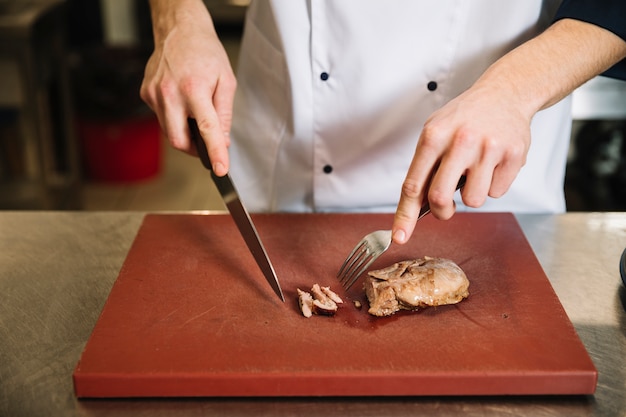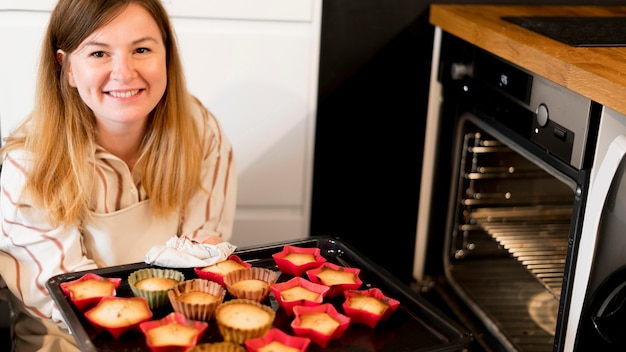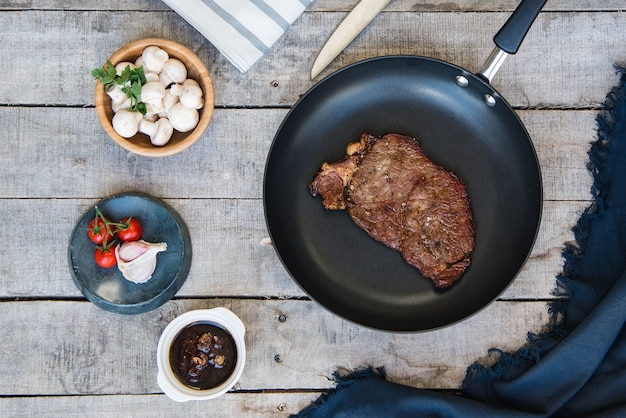Let's be honest, sometimes the best meals are the simplest ones. A perfectly cooked steak, sizzling on the stovetop, is a culinary masterpiece that doesn't require a Michelin-star chef. But let's face it, there's a world of difference between a tough, overcooked hunk of meat and a steak that's so tender and flavourful, it practically melts in your mouth.
Over the years, I've been on a quest to perfect my steak game, and trust me, it's a journey worth taking. I've experimented with different cuts, tried countless seasoning combinations, and even made my fair share of mistakes along the way. But through it all, I've learned some valuable lessons.
This guide isn't just about throwing a steak in a pan and calling it a day. It's about understanding the science behind achieving that perfect sear, the art of choosing the right cut, and the magic of finishing touches that elevate your steak from ordinary to extraordinary. So grab your apron, let's dive in and unlock the secrets to the most succulent steak you've ever tasted!
Part 1: Choosing the Right Cut: The Foundation of Flavor

A great steak starts with a great cut of meat. It's like building a house – you wouldn't start with a flimsy foundation, would you? The same principle applies to steak. Choosing the right cut is crucial for achieving a delicious and satisfying result.
The Champions League: Cuts for Every Occasion
Sirloin: This classic cut is a true workhorse. It's lean, with a good amount of flavour, and responds beautifully to quick searing methods. It's the perfect choice for a weeknight dinner when you want something tasty and satisfying without spending too much time in the kitchen.
Rib-eye: Now, this is where things get serious. Rib-eye is renowned for its rich, buttery flavour and generous marbling, which adds a layer of tenderness and richness. Think of it as the superstar of the steak world, perfect for special occasions or when you want to impress.
new york strip: This cut is a bit like the sirloin's more glamorous cousin. It has a wider strip of fat than the sirloin, which translates to a more intense flavour. It's often considered to be the ideal balance between tenderness and flavour.
The Underdog Champions: Don't Sleep on These
Flank: This cut is known for its intense flavour, but it can be a bit tougher than the other options. The key is to cook it quickly and slice it thinly against the grain. Think of flank steak as a blank canvas for bold flavours. It's perfect for stir-fries, fajitas, or marinades that really pack a punch.
Skirt: skirt steak is like the more tender version of flank. It's still a bit tougher than the other cuts, but it holds its own in quick cooking methods like grilling or stir-frying. It's a real crowd-pleaser and a fantastic option for fajitas.
Part 2: Prep Work: Setting the Stage for Success

Remember, good things take time. A bit of pre-game prep is key to achieving that perfect steak. It's like a musician warming up before a performance – you wouldn't expect a virtuoso to just jump on stage and start playing, would you?
Temperature is King: The Science of Even Cooking
The Room Temperature Rule: Never cook a steak straight from the fridge! It's a recipe for uneven cooking. The outside might be charred, while the inside stays cold and raw. Bring your steak to room temperature for about 30 minutes before cooking. This ensures it cooks evenly from the outside in.
Seasoning: The Art of Bringing Out the Best
Salt and Pepper, the Essential Duo: Always use freshly ground pepper, it makes a world of difference! A coarse sea salt adds a satisfying crunch and enhances the steak's natural flavours.
Go Beyond the Basics: The Flavor Experimentation Game
Smoked Paprika: This adds a smoky depth that's perfect for a steak with a bit of rustic charm.
Garlic Powder: For a subtle hint of garlic flavour that complements the steak beautifully.
Chili Flakes: If you like a little heat, add a pinch of chili flakes to your seasoning blend. But be warned, they can pack a punch!
Part 3: The Sizzle: Mastering the Art of Searing

Now comes the exciting part – the sear! This is where you transform a simple piece of meat into something truly mouthwatering.
Pan Selection: Choosing Your Weapon
cast iron pan: The Classic Choice: Cast iron is my personal favourite for searing steak. It gets incredibly hot and retains the heat well, creating a beautiful, crisp crust. Plus, if you take care of it, a good cast iron pan will last you a lifetime.
Stainless Steel: A Solid Alternative: If you don't have a cast iron pan, a heavy-bottomed stainless steel pan is a good option. It's not quite as good at retaining heat as cast iron, but it will still get the job done.
Heat is Your Friend: Creating a Sizzling Symphony
Get It Smoking Hot: The key to a perfect sear is high heat. You want your pan to be so hot that it starts to smoke. This is the sweet spot for creating that crispy, caramelized crust.
Don't Crowd the Pan: Give your steaks some space! Cram too many in the pan, and they'll steam instead of sear. You want them to cook evenly on all sides, so spread them out to ensure they have plenty of room to breathe.
The Flip Technique: A Dance of Timing
The Patience Game: Resist the urge to flip your steak too early. Let it cook undisturbed for 2-3 minutes on the first side. You want to build up a nice, thick crust.
The Flip: Once that first side is beautifully browned, it's time to flip it. Flip the steak with confidence and cook the other side for another 2-3 minutes.
Rest and Relaxation: Let the Steak Rejuvenate
Don't Cut It!: Once your steak is cooked to your liking, it's essential to let it rest for 5-10 minutes before cutting into it. This allows the juices to redistribute, ensuring a more tender and juicy steak.
Part 4: internal temperatures: Decoding steak doneness
No one wants a dry, overcooked steak. The key is to understand how to cook it to the perfect level of doneness.
Rare: A Touch of Red
Internal Temperature: 125-130°F (52-54°C)
Feel: The center of the steak will be cool and red, with a soft, yielding texture.
Medium-Rare: A Kiss of Pink
Internal Temperature: 130-135°F (54-57°C)
Feel: The center of the steak will be slightly warm and red, with a slight springiness to the touch.
Medium: A Touch of Pink at the Center
Internal Temperature: 140-145°F (60-63°C)
Feel: The center of the steak will be warm and pink, with a firmer texture.
Medium-Well: Mostly Browned
Internal Temperature: 150-155°F (65-68°C)
Feel: The center of the steak will be hot and only slightly pink, with a firm texture.
Well-Done: Fully Browned
Internal Temperature: 160°F (71°C)
Feel: The center of the steak will be hot and fully brown, with a firm and chewy texture.
The meat thermometer: Your Trusty Companion
Don't Be Afraid!: A meat thermometer is your best friend! It takes the guesswork out of cooking and ensures your steak is cooked to your liking every time.
Placement is Key: Insert the thermometer into the thickest part of the steak, making sure it doesn't touch any bone.
Part 5: The Finish: Adding Flavor and Texture
You've got your steak seared and cooked to perfection. Now it's time to add those final touches that will transform it from a good steak to a truly memorable one.
Sauce It Up: The Magic of Flavor Enhancement
Butter and Herbs: The Classic Approach: A knob of butter melted in the pan, swirled around and infused with aromatic herbs like thyme, rosemary, or sage, adds a layer of richness and flavour that's hard to resist.
Wine Sauce: A Touch of Elegance: For a more sophisticated touch, deglaze the pan with a splash of dry red wine. Add a tablespoon of butter and stir until it's emulsified. The result is a silky sauce that complements the steak beautifully.
Pan Sauce: Making the Most of the Drippings: Use the delicious pan drippings to create a simple yet flavourful sauce. Add a tablespoon of butter, a splash of broth, and some chopped herbs. It's a quick and easy way to elevate your steak to the next level.
side dishes: Complementary Companions
Potatoes: The Perfect Pairing: Roasted potatoes, mashed potatoes, or fries – they all complement a juicy steak wonderfully.
Vegetables: Adding a Touch of Freshness: Asparagus, broccoli, green beans, or a mixed salad add a burst of freshness to your meal.
Salad: A Refreshing Counterpoint: A crisp salad provides a refreshing contrast to the richness of the steak.
Part 6: Mastering Different cooking techniques
Sometimes, you want to shake things up a bit. Let's explore different methods for cooking a steak beyond the traditional pan-searing approach.
reverse searing: Low and Slow for Tenderness
The Low and Slow Method: This technique involves cooking the steak at a low temperature for a longer period before searing it at high heat. This results in a more tender and juicy steak, as the low heat allows the muscle fibres to relax.
Oven Cooking: Preheat your oven to 250°F (120°C). Place the steak on a baking sheet and cook for 30-45 minutes, depending on the thickness of the steak. Then sear it in a hot pan for 1-2 minutes per side to give it that beautiful crust.
Grill It Up: The Charm of Smoky Flavors
Hot and Smoky: A grill is a fantastic way to cook steak, adding a smoky flavour that's hard to beat. Preheat your grill to high heat and cook the steak for 2-3 minutes per side. Add wood chips to your grill for an even more intense smoky flavour.
Air Fryer Delight: Fast and Crispy Results
Quick and Easy: An air fryer is a great way to cook steak quickly and evenly. Preheat your air fryer to 400°F (200°C) and cook the steak for 5-7 minutes per side. This method gives you a crispy exterior and a tender interior, with minimal effort.
Part 7: steak cuts: A Closer Look
Let's delve deeper into the world of steak cuts and their characteristics:
| Cut | Description | Cooking Methods | Best For |
|---|---|---|---|
| Sirloin | Lean cut with good flavour, suitable for quick cooking methods like pan-searing or grilling. | Pan-searing, grilling, broiling | quick and easy meals, everyday dinners |
| Rib-eye | Rich flavour and generous marbling, ideal for slower cooking methods like roasting or grilling. | Roasting, grilling, pan-searing | Indulgent meals, special occasions, steak lovers |
| New York Strip | Similar to sirloin but with a wider, more flavorful strip of fat, excellent for searing and grilling. | Pan-searing, grilling | Special occasions, showcasing the steak's flavour |
| Flank | Tougher but packed with flavour, best cooked quickly and sliced thinly against the grain. | Grilling, stir-frying, slicing for fajitas | Quick meals, stir-fries, fajitas, bold flavour profiles |
| Skirt | Similar to flank but more tender, perfect for fajitas or quick grilling. | Grilling, stir-frying, slicing for fajitas | Fajitas, quick meals, grilling |
Part 8: steak storage and Leftovers: Making the Most of Your Meal
Got leftovers? Don't let them go to waste! There are plenty of ways to make the most of a delicious leftover steak.
Storage:
Refrigerate: Wrap your cooked steak tightly in plastic wrap or aluminum foil and store it in the refrigerator for up to 3-4 days.
Freeze: For longer storage, you can freeze cooked steak for up to 3 months. Wrap it tightly in plastic wrap and then again in aluminum foil.
Leftover Magic: Creative Ways to Reimagine Your Steak
Steak Sandwiches: Slice the leftover steak and pile it onto a toasted roll with your favorite toppings, like cheese, onions, and sauce.
Steak Salad: Slice the leftover steak and add it to a mixed greens salad with a vinaigrette dressing.
Steak Hash: Chop up the leftover steak and add it to a hash with potatoes, onions, and peppers for a hearty and flavourful meal.
Part 9: FAQs: Steak Savvy
Let's address some common questions that often arise when it comes to cooking steak:
1. How Long Does it Take to Cook a Steak?
The cooking time for a steak depends on its thickness and the desired level of doneness. A 1-inch thick steak will typically take about 4-5 minutes per side for medium-rare. Always use a meat thermometer to ensure it's cooked to your liking.
2. What If I Overcook My Steak?
Don't panic! It happens to the best of us. If you overcook your steak, it will be tough and dry. Try to salvage it by slicing it thinly and using it in a dish like a stir-fry or a salad.
3. Can I Cook a Steak in the Oven?
Absolutely! The reverse searing method is a great way to cook steak in the oven. Preheat your oven to 250°F (120°C) and cook the steak for 30-45 minutes, depending on its thickness. Then sear it in a hot pan for 1-2 minutes per side to give it a crispy crust.
4. What Kind of Wine Should I Use to Deglaze the Pan?
A dry red wine like Cabernet Sauvignon or Merlot is a good choice for deglazing the pan. The tannins in the wine help to create a rich and flavorful sauce.
5. What's the Best Way to Cut a Steak?
Always cut your steak against the grain. This means slicing across the muscle fibers, which helps to make it more tender and easier to chew.
So there you have it, the ultimate guide to achieving perfect stovetop steak. Now, go forth, my culinary friends, and unleash your inner steak master! Remember, practice makes perfect, so don't be afraid to experiment and find what works best for you. And most importantly, enjoy the journey!
Everyone is watching

Prime Rib Roast Cooking Time Chart: Per Pound Guide
Cooking TipsPrime rib roast. Just the name conjures images of lavish dinners, crackling fires, and hearty laughter. It’s ...

How Long to Bake Potatoes in the Oven (Perfect Every Time)
Cooking TipsBaked potatoes are a staple in my kitchen. They're incredibly versatile, delicious, and surprisingly easy to m...

Perfect Rice Every Time: The Ultimate Guide to Cooking Rice
Cooking TipsAs a self-proclaimed foodie, I've always been a bit obsessed with rice. It's the foundation of countless cuisi...

The Ultimate Guide to Cooking Asparagus: Tips, Techniques, and Recipes
Cooking TipsAsparagus. The mere mention of this spring delicacy conjures up images of vibrant green spears, crisp and burs...

Ultimate Guide to Cooking the Perfect Thanksgiving Turkey
Cooking TipsThanksgiving. Just the word conjures up images of overflowing tables laden with delicious food, the scent of r...
